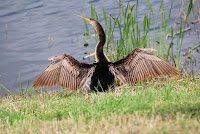 The Viera Wetland roads were closed for a few days so that County workers could smooth out the potholes, but the weather has been lovely and people have walked the dike roads instead of driving them. Friend Wayne snapped this photo on a recent visit. I like what appears to be a man and a bird having a conversation, although Wayne tells me that's just my over-active imagination kicking in.
The Viera Wetland roads were closed for a few days so that County workers could smooth out the potholes, but the weather has been lovely and people have walked the dike roads instead of driving them. Friend Wayne snapped this photo on a recent visit. I like what appears to be a man and a bird having a conversation, although Wayne tells me that's just my over-active imagination kicking in.Our recent posts have been pretty wordy, so I thought you might enjoy these photos of some of the residents at the Wetlands and nearby Click Ponds.


This is a young Crested Caracara - one of a family in residence this year at the Wetlands. Wayne thought perhaps the parents and sibling had deserted this little fellow, but after a few days of investigation, he located the other family members. The Caracara is the national bird of Mexico, and I've always thought that little black hat and beady-eyed stare had a definite Latin look! Caracaras are frequently seen walking and running on the ground. Or like this one, waiting for somebody to pick him up after basketball practice! (Doesn't he look just like a teenager waiting for Mom? I assume he knows how to roll his eyes and sigh.) Be sure to click to enlarge the photos - they really show this little guy's personality.
You'll frequently see the adult Anhingas drying their wings in the sun - these birds do not come equipped with the standard oil gland that birds use to waterproof their feathers. Anhingas swim mostly below water, sticking just that long neck and head out (earning them the nickname of snake bird), and thus lose a lot of body heat. Cornell ornithologists maintain that the Anhinga basks in the sun primarily to regulate its body temperature, not just to dry its feathers. The male Anhinga is black with beautiful silver patches on its wings. The female has a brown head and neck and no bling (go figure). The above photo shows the Anhinga's sharp, pointed beak that allows it to spear fish.
It's easy to confuse the Cormorant and the Anhinga. They are about the same size - approximately two feet long, with a wingspan of about four feet. The Pelican, Cormorant, and Anhinga are related, and all have four webbed toes (instead of three like other waterbirds). The Cormorant (shown above) has dark brown or black feathers, a hooked bill, and an orange throat pouch. You can see the hooked bill in this photo - that bill feature dictates how it obtains its food. It dives for fish from the water's surface, flips the fish in the air, and swallows it head-first.
(Here's a trick to remember which is which - the Cormorant's bill has a hook, like a C. The Anhinga bill is straight, like the side of an A.)
This is just a small sample of what you might see during your field trip to Viera Wetlands and Click Ponds, so grab your cameras and head on out there!
As always, our thanks to Wayne Matchett for sharing his photos and his expertise. (Be sure to click on the photos to enlarge.)









No comments:
Post a Comment
Note: Only a member of this blog may post a comment.